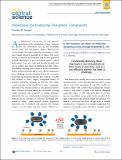Impedance for Endocrine Disruption Compounds
Author(s)
Swager, Timothy M
Downloadacscentsci.7b00045.pdf (648.2Kb)
PUBLISHER_POLICY
Publisher Policy
Article is made available in accordance with the publisher's policy and may be subject to US copyright law. Please refer to the publisher's site for terms of use.
Terms of use
Metadata
Show full item recordAbstract
An unintended consequence of our chemical innovations is the introduction of trace chemicals into our environment that are not necessarily directly toxic, but can impact nature. Mutations in animals/people can happen naturally, but perhaps in many cases human chemical ingenuity is to blame. Our motivations as chemists are honorable, and we have generated pesticides that help us to grow more food, agents to extract hydrocarbons from the earth, and durable materials that can be washed and reused in drinking and baby bottles. Functionally detecting these chemicals in our environment at trace levels, in real time, and in a cost-effective manner has been a challenge. Professor Matthew Francis and co-workers Ariel Furst and Alexander Hoepker have devised a powerful new method to detect suspect compounds known as endocrine disrupting chemicals. In this issue they report a novel assay that can functionally detect suspect compounds that bind to the estrogen receptor α. This approach involves direct electrical detection, which has the benefit of being readily interfaced with a number of existing platforms. Specifically, this team developed electrochemical impedance methods for the detection of endocrine disrupting compounds by using a novel sandwich scheme. Engineered Escherichia coli is produced that expresses the estrogen receptor α on its surface, and this structure behaves as a very large blocking scaffold that can restrict diffusion of ions to an electrode.
Date issued
2017-01Department
Massachusetts Institute of Technology. Department of ChemistryJournal
ACS Central Science
Publisher
American Chemical Society (ACS)
Citation
Swager, Timothy M. “Impedance for Endocrine Disruption Compounds.” ACS Central Science 3, 2 (January 2017): 99–100 © 2017 American Chemical Society
Version: Final published version
ISSN
2374-7943
2374-7951